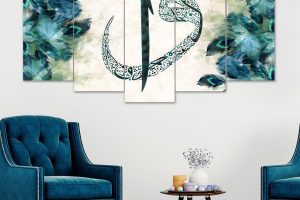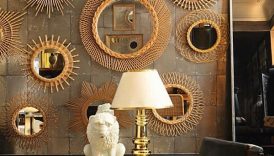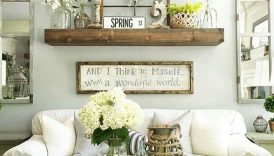Crafting Tranquility: The Impact of Islamic Wall Art on Your Space

Understanding Islamic Wall Art
Islamic wall art serves as a profound expression of faith, culture, and creativity. Characterized by intricate designs, vibrant colors, and meaningful symbols, this form of art transcends mere decoration. It invites contemplation and reflection, allowing the viewer to connect deeply with the aesthetics of Islamic culture. Imagine walking into a room adorned with lush calligraphy or geometric patterns that seem to tell a story—each piece not only adds visual appeal but also carries historical and spiritual significance. From mosques to homes, Islamic art can be found in various forms, including tiles, paintings, and tapestries, showcasing an unparalleled legacy that has evolved over centuries.
- Crafting Tranquility: The Impact of Islamic Wall Art on Your Space
- Understanding Islamic Wall Art
- Significance of Art in Islamic Culture
- History of Islamic Wall Art
- Origins and Influences
- Evolution over the Centuries
- Symbolism in Islamic Wall Art
- Common Motifs and Patterns
- Religious and Cultural Representations
- Techniques and Materials Used in Islamic Wall Art
- Calligraphy and Geometry
- Traditional vs. Contemporary Approaches
- Benefits of Islamic Wall Art in Home Décor
- Creating a Serene Environment
- Enhancing Spiritual Connection
- Incorporating Islamic Wall Art in Modern Interiors
- Tips for Placement and Pairing
- Customization and Personalization Options
Significance of Art in Islamic Culture
Art holds an essential place in Islamic culture, often intertwining with identity, spirituality, and community. Unlike Western art, which frequently depicts human figures, Islamic art emphasizes abstraction and pattern, focusing on the divine rather than the mortal. Key aspects of this significance include:
- Cultural Identity: Islamic art reflects the diverse cultures within the Islamic world, showcasing regional styles and techniques.
- Spiritual Connection: Many works of art serve as a medium for spiritual expression, inviting contemplation on faith and devotion.
- Community Engagement: Art fosters a communal spirit, as seen in traditional crafts that may involve entire families or neighborhoods working together.
Such elements contribute to a rich tapestry of meaning, making Islamic wall art a vital component of worship and everyday life. By appreciating this art form, one not only celebrates its beauty but also acknowledges its profound impact on culture and spirituality.
History of Islamic Wall Art
Origins and Influences
The origins of Islamic wall art can be traced back to the early years of Islam, where diverse influences coalesced to create unique artistic expressions. Emerging within a vast geographic expanse, Islamic art reflects the fusion of various cultures, including the Byzantine, Persian, and Indian styles. What’s fascinating is how these influences came together, blending traditions from different civilizations. For instance:
- Byzantine Influence: The use of lush colors and intricate motifs in Byzantine art laid a foundation for the aesthetic that would flourish in Islamic regions.
- Persian Contributions: Floral designs and elaborate patterns were incorporated, becoming hallmarks of Islamic art.
- Cultural Adaptations: Local customs and materials also played a role in shaping art forms, resulting in an array of distinctive styles reflective of specific communities.
Evolution over the Centuries
As time progressed, Islamic wall art evolved significantly, adapting to changing tastes and technologies. During the Islamic Golden Age (8th to 14th centuries), art flourished with the support of powerful patrons and patrons, including caliphs and sultans. Some notable changes over the centuries include:
- Increased Use of Calligraphy: The practice of integrating Arabic script became more refined, emphasizing not just beauty but also conveying religious texts.
- Geometric Designs: The restriction against depicting living beings led to a rise in complex geometric patterns, representing infinity and the divine.
- Regional Variations: From the vibrant tiles of Moroccan architecture to the delicate Persian miniatures, each region cultivated its interpretations, enriching the overall tapestry of Islamic art.
This rich historical journey underscores how Islamic wall art has not only survived but thrived, continually adapting to reflect the changing landscapes of culture, faith, and identity.
Symbolism in Islamic Wall Art
Common Motifs and Patterns
Diving deeper into the world of Islamic wall art, one begins to appreciate the profound symbolism woven into its intricate designs. The most common motifs, while aesthetically pleasing, offer layers of meaning often tied to spirituality and community life. Let’s explore some of these motifs:
- Geometric Patterns: Representing the infinite nature of creation, these designs reflect the underlying order and beauty of the universe. They often form complex interlocking shapes, guiding the eye and evoking a sense of harmony.
- Floral Designs: Common in Persian art, floral patterns symbolize life and the beauty of nature. They often include motifs like the rose or lotus, conveying a connection to Eden and a longing for paradise.
- Calligraphy: This art form transforms words into visual masterpieces. Quotations from the Quran or verses celebrating faith are frequently depicted, emphasizing the importance of language in expressing devotion.
Each pattern holds not just beauty but also a story, enriching the experience of those who view it.
Religious and Cultural Representations
Beyond visual appeal, Islamic wall art serves as a potent vehicle for religious and cultural representations. Many pieces convey profound messages that resonate with both spiritual and everyday life. For instance:
- Stars and Moons: Often associated with Islamic iconography, these elements signify guidance, both in a celestial sense and within a spiritual journey.
- Mosaics and Tiles: Predominantly found in grand mosques and palaces, these artworks embody a community’s craftsmanship and cultural identity. Each tile often tells a story about local traditions and heritage.
Incorporating Islamic wall art into one’s living space can create an invitation to reflect on deeper meanings. As one admires the patterns, they may find themselves contemplating not just the artwork but what it represents in terms of faith, culture, and connection to a larger community—a true celebration of heritage through art.
Techniques and Materials Used in Islamic Wall Art
Calligraphy and Geometry
One cannot discuss Islamic wall art without acknowledging the masterful techniques that define it, especially calligraphy and geometry. Calligraphy, often considered the highest form of art in Islam, goes beyond mere words; it transforms sacred texts into stunning visual pieces. In my travels through different mosques, I’ve marveled at how beautifully the Arabic script flows, often conveying verses from the Quran or wise sayings. Here’s what makes it special:
- Naskh and Thuluth Styles: These traditional scripts vary in elegance and clarity, with Naskh being more readable for everyday use, while Thuluth showcases grandeur, often used in monumental inscriptions.
- Integration with Geometric Patterns: Calligraphy frequently intertwines with intricate geometric designs, creating a balanced composition that leads the viewer’s eye across the piece.
Geometry itself is a cornerstone of Islamic art, symbolizing the infinite. Its patterns are not arbitrary; they invite contemplation and serve as a reminder of the divine order.
Traditional vs. Contemporary Approaches
The realm of Islamic wall art has also witnessed significant shifts in technique and materials, leading to a dynamic dialogue between traditional and contemporary approaches.
- Traditional Techniques: Artists would typically use materials like plaster, wood, and ceramic tiles, employing time-honored methods passed down through generations. For instance, the age-old practice of tile-making involves meticulous attention to detail and is labor-intensive.
- Contemporary Interpretations: Today, artists are embracing new materials and techniques, blending traditional themes with modern aesthetics. The use of digital technology allows for vibrant reproductions, making Islamic art accessible for a wider audience.
When visiting a modern art gallery, one might encounter Islamic art displayed through digital installations or contemporary sculptures, bridging the gap between past and present. This evolution showcases how Islamic wall art remains relevant, continuously inspiring both artists and admirers alike. By incorporating both traditional and contemporary elements, it speaks to the enduring nature of culture and creativity.
Benefits of Islamic Wall Art in Home Décor
Creating a Serene Environment
Integrating Islamic wall art into home décor offers a plethora of benefits, chief among them being the creation of a serene environment. The intricate patterns and soothing colors often found in Islamic art can transform any room into a sanctuary. For example, a beautifully crafted geometric tile mural in a living room can serve as a focal point, drawing the eye and promoting a sense of calm. This is especially true in spaces meant for relaxation or reflection, such as a reading nook or meditation area. Here are a few ways Islamic wall art contributes to a tranquil setting:
- Harmonious Colors: The earthy tones often used in Islamic art can evoke a feeling of peace and stability.
- Mindful Imagery: Designs such as floral motifs or calligraphy invite thoughtful contemplation, providing a mental respite from the fast-paced world outside.
Incorporating such art not only beautifies a space but also fosters an ambience of tranquility, making home a place of rejuvenation.
Enhancing Spiritual Connection
In addition to fostering serenity, Islamic wall art can significantly enhance one’s spiritual connection. Many pieces incorporate verses from the Quran or representations of divine attributes, inviting deeper reflection and meditation. Imagine standing in a room adorned with exquisite Arabic calligraphy, each letter and curve encapsulating profound wisdom and spirituality. Engaging with such art can inspire:
- Increased Mindfulness: Being surrounded by spiritual representations can remind individuals to cultivate a mindful approach to daily life.
- Cultural Appreciation: Displaying Islamic art also becomes a narrative of cultural respect and appreciation, allowing inhabitants to connect with a rich artistic heritage.
As people interact with this art daily, it fosters a sense of connection not only to their own faith but also to a broader community and cultural history. Through Islamic wall art, homes can become more than just living spaces; they transform into havens of peace and spiritual reflection.
Incorporating Islamic Wall Art in Modern Interiors
Tips for Placement and Pairing
Integrating Islamic wall art into modern interiors can create a stunning contrast between tradition and contemporary design. To achieve a harmonious blend, strategic placement and pairing are essential. As someone who recently redecorated their living space, I discovered that a simple piece of Islamic art can change the entire vibe of a room. Here are some effective tips for placement and pairing:
- Focal Points: Choose a prominent wall—perhaps in the living room or entryway—where the artwork can stand out. A large piece of calligraphy or geometric art can serve as a striking focal point that captures attention.
- Complementary Colors: When selecting art, consider the existing color palette of the room. Opt for pieces that either match or complement the hues in your décor, creating visual harmony.
- Mix and Match: Don’t hesitate to combine Islamic art with other styles. Pairing it with minimalist or Scandinavian designs can enhance its uniqueness, showing how traditional art can fit seamlessly within modern interiors.
Customization and Personalization Options
Another wonderful aspect of Islamic wall art is the opportunity for customization and personalization. This allows individuals to create pieces that resonate more deeply with their personal experiences and belief systems.
- Bespoke Commissions: Consider commissioning an artist to create a unique piece that represents significant verses, personal symbols, or memories. This can be incredibly fulfilling and meaningful.
- Personalized Colors and Materials: Customized art can also embrace colors and materials that fit perfectly with your interior. For instance, selecting tiles that match your kitchen’s backsplash or finding art that utilizes reclaimed wood can create a cohesive feel.
- Family Heritage: Incorporating elements that reflect your family’s heritage—such as emblematic patterns or historical quotes—can make the artwork even more special.
By thoughtfully considering placement and opting for personalized pieces, Islamic wall art not only enhances modern interiors but also transforms them into spaces rich with meaning and connection.





